Labour Force
- Home
- Statistics
- Labour Market
- Labour Market Information
- Labour Force
Key Statistics of Labour Force in Malaysia, October 2020
Key Statistics of Labour Force in Malaysia, September 2020 9 November 2020
Principal Statistics of Labour Force, Malaysia, Third Quarter (Q3) 2020 13 October 2020
Key Statistics of Labour Force in Malaysia, August 2020 11 September 2020
Key Statistics of Labour Force in Malaysia, July 2020 7 August 2020
Key Statistics of Labour Force in Malaysia, June 2020 7 August 2020
Principal Statistics of Labour Force, Malaysia, Second Quarter (Q2) 2020 Show all release archives
Overview
.jpg)
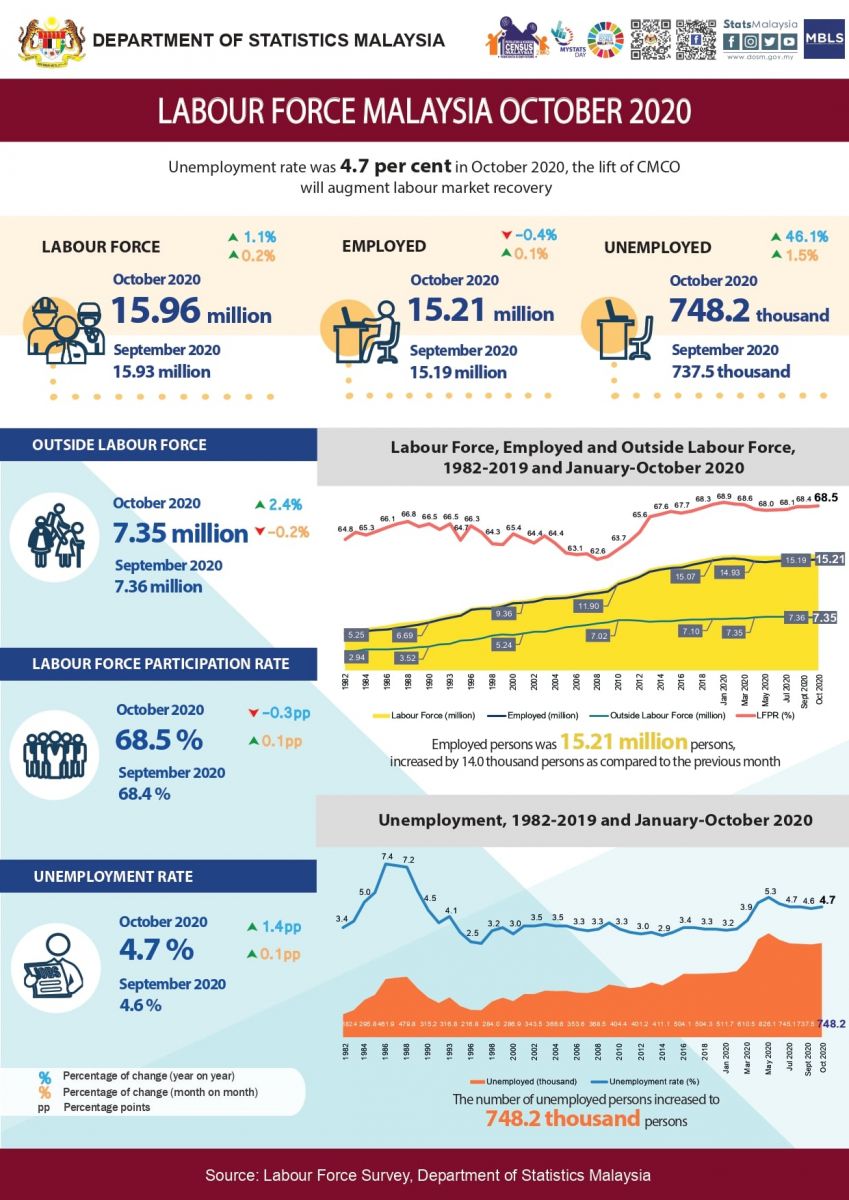
KEY REVIEWS
- In October 2020, employed persons registered an uptrend for five consecutive months with a marginal growth of 0.1 per cent month-on-month or equivalent to 14 thousand persons to record 15.21 million persons. The employment-to-population ratio rose 0.1 percentage point to 65.3 per cent in October 2020.
- In terms of economic sector, the number of employed persons in the Services sector continued to increase, largely in Wholesale & retail trade; Education and Communication & information activities. In the meantime, employment in Construction sector posted an increase while the Agriculture, Manufacturing and Mining & quarrying sectors registered a decline.
- Analysis by status of employment shows that employed persons in the employee’s category increased by 28.1 thousand persons (0.2%) to register 11.76 million persons as compared to the previous month. On the contrary, own-account workers decreased by 0.3 per cent to record 2.43 million persons as against September 2020.
- In October 2020, the unemployment rate rose 0.1 percentage point to 4.7 per cent as against September 2020 after registering a decreasing trend for four consecutive months since June 2020. The number of unemployed persons increased 1.5 per cent to register 748.2 thousand persons (September 2020: 737.5 thousand persons).
- October 2020 saw the labour force participation rate (LFPR) went up by 0.1 percentage point to 68.5 per cent as compared to the previous month. Similarly, the number of labour force rose to 15.96 million persons with an increase of 24.7 thousand persons month-on-month (September 2020: 15.93 million persons).
- The number of persons outside labour force edged down by 0.2 per cent (-12.1 thousand persons) to 7.35 million persons during the month (September 2020: 7.36 thousand persons). The largest composition of outside labour force was due to schooling/ training which contributed 43.4 per cent followed by housework/ family responsibility with a share of 41.1 per cent.
- As we entered the final month of 2020, the CMCO is being lifted in phases starting 7 December, permitting inter-state travel and businesses to operate as usual. This will partly lead the economic sectors to regain its momentum following higher demand and subsequently encouraging businesses to retain or even to increase job opportunities. This positive impact has been seen when the CMCO was lifted in June where the economy improved significantly with a single-digit decline in the third quarter 2020 and the number of unemployed continued to decrease throughout June until September.
MALAYSIA’S LABOUR MARKET PICKED UP AT A SLOWER PACE
Malaysia’s relentless fight against COVID-19 pandemic was manifested through eight months of Movement Control Order (MCO) encompassing the strict measures of total lock down to educate the community on the new norm and later transitioned to Conditional MCO (CMCO) and Recovery MCO (RMCO) as the people slowly accustomed themselves to life amidst COVID-19. During the recovery phase, the businesses operations were reinstated albeit not at the optimum level. Nevertheless, with the numerous stimulus packages provided by the Government to soften the negative impact of the pandemic and revitalise the economy, it was observed that the labour force situation continued its upward trend since June 2020.
The Government has taken a proactive action by implementing the CMCO in targeted areas to curtail the spread of the pandemic. In this regard, as Malaysia experienced the third wave of COVID-19 pandemic since early October 2020, the labour market was also impacted. Employment in October 2020 recorded a slower month-on-month growth. In the meantime, the unemployment rate also increased due to the impact felt by certain businesses especially tourism related industry such as airlines services and accommodation activities. Consequently, the number of labour force during similar period increased slightly.
The economic performance in October 2020 indicated further improvement in the Industrial Production Index (IPI) with a positive growth of 1.7 per cent month-on-month to record 117.3 supported by IPI for Manufacturing which increased by 0.1 per cent. On top of that, both imports and exports posted a month-on-month growth of 2.9 per cent and 2.4 per cent respectively.
The Labour Force Report for October 2020 describes the labour supply situation as the country entered the eighth month of MCO. The report will elaborate on the month-on-month changes to examine the immediate effects of the MCO to contain the spread of COVID-19. Users are advised to interpret the monthly statistics with caution since they are non-seasonally adjusted. In addition, annual changes from the same month of the previous year is also reported. .
Employment recorded a marginal increase of 0.1 per cent
In October 2020, employed persons registered an uptrend for five consecutive months with a marginal growth of 0.1 per cent month-on-month or equivalent to 14 thousand persons to record 15.21 million persons. Nevertheless, a declining year-on-year trend was observed since April 2020, whereby the number of employed persons during the month declined 0.4 per cent (October 2019: 15.27 million persons).
In terms of economic sector, the number of employed persons in the Services sector continued to increase, largely in Wholesale & retail trade; Education and Communication & information activities. Nevertheless, the CMCO has adversely affected the operational and employment in tourism related industry such as accommodation and food & beverages; transports & storage; and arts, entertainment & recreational activities. In the meantime, employment in Construction sector posted an increase while the Agriculture, Manufacturing and Mining & quarrying sectors registered a decline.
As most of the states underwent the Conditional Movement Control Order (CMCO) effective 14 October 2020, industrial and businesses activities continued their operation with compliance to a strict standard operating procedure. Hence, the labour market remained in modest condition. In line with this, the employment-to-population ratio which indicates the ability of an economy to create employment rose 0.1 percentage point to 65.3 per cent in October 2020. Meanwhile, year-on-year, employment-topopulation ratio dropped by 1.2 percentage points from 66.5 per cent. [Chart 1]
Chart 1: Employed persons and employment-to-population ratio, January 2018 – October 2020
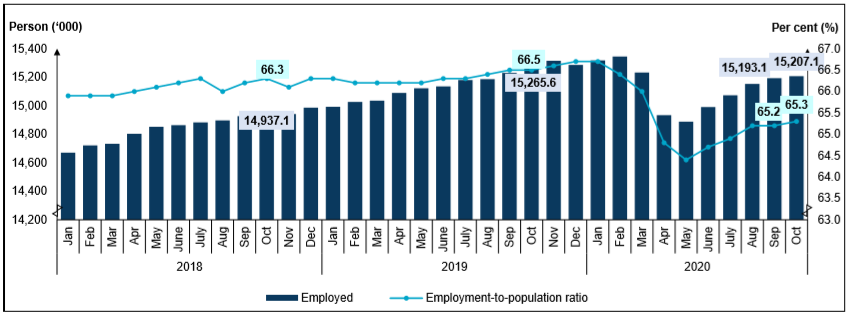
Analysis by status of employment shows that employed persons in the employee’s category increased by 0.2 per cent (+28.1 thousand persons) to register 11.76 million persons as compared to the previous month. On the contrary, own-account workers decreased by 0.3 per cent to record 2.43 million persons as against September 2020. This group comprised mostly of daily wage earners working in farmers’ markets, night markets and stalls; freelancers; as well as smallholders. [Chart 2]
Chart 2: Employed person by status in employment, September and October 2020
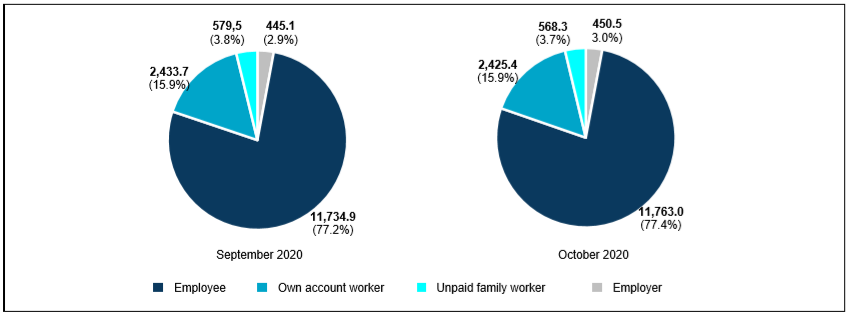
Meanwhile, there were 183.6 thousand employed persons who were temporarily not working as against 100.7 thousand persons registered in September 2020. This group of persons, who were most likely not able to work was not categorised as unemployed as they had work to return to. The increase in the total number of employed persons who were temporarily not working among others was due to the implementation of CMCO in five states as well as the Enhanced Movement Control Order (EMCO) in certain areas.
Unemployment rate rose to 4.7 per cent
In October 2020, the unemployment rate rose 0.1 percentage points to 4.7 per cent as against September 2020 after registering a decreasing trend for four consecutive months since June 2020. The number of unemployed persons increased by 1.5 per cent to register 748.2 thousand persons (September 2020: 737.5 thousand persons).
However, the unemployment rate for October 2020 increased 1.5 percentage points year-on-year, with the number of unemployed persons recorded an increase of 236.1 thousand persons (October 2019: 512.1 thousand persons). [Chart 3]
Chart 3: Unemployed persons and unemployment rate, 1982 - 2019 and January - October 2020

More than 80 per cent of unemployed persons in October 2020 was actively unemployed. Among this group, the largest share of 48.9 per cent were unemployed for less than three months. In the meantime, those in long-term unemployment1 for more than a year registered 10.0 per cent or 62.2 of total unemployed person.
The inactively unemployed or discouraged group whom believed there were no jobs available during the month recorded a decrease of 0.5 percentage points to 125.1 thousand persons as against 127.1 thousand persons in September 2020. [Chart 4]
Chart 4: Unemployed category and duration of unemployment, September and October 2020
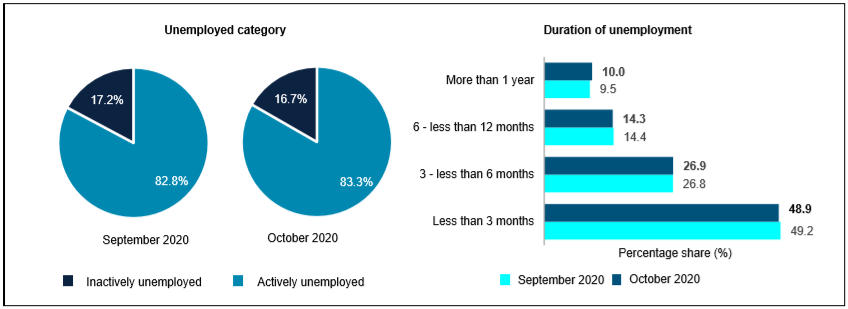
In October 2020, the youth unemployment rate for aged 15 to 24 years, increased by 0.4 percentage points to 13.4 per cent as compared to the previous month (September 2020: 13.0%). Likewise, the unemployment rate for youth aged 15 to 30 years rose to 8.9 per cent (September 2020: 8.5%). [Chart 5]
Chart 5: Unemployment rate by selected age groups, 1982 - 2019 and January - October 2020
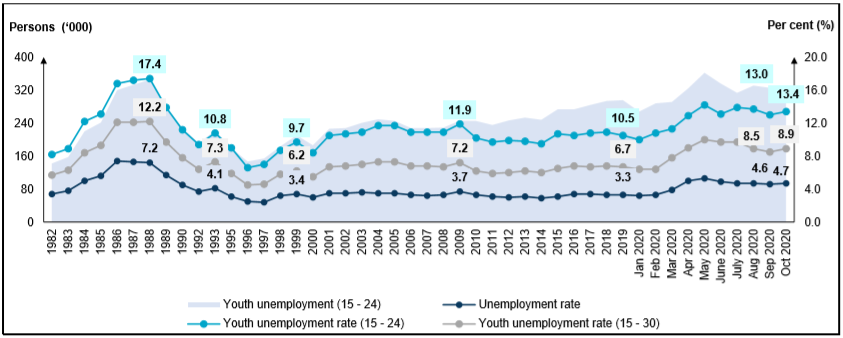
LFPR went up by 0.1 percentage point to 68.5 per cent
October 2020 saw the labour force participation rate (LFPR) went up by 0.1 percentage point to 68.5 per cent as compared to the previous month. Similarly, the number of labour force rose to 15.96 million persons with an increase of 24.7 thousand persons month-on-month (September 2020: 15.93 million persons).
Year-on-year, the number of labour force went up by 177.6 thousand persons from 15.78 million persons (October 2019), meanwhile the LFPR fell by 0.2 percentage points (October 2019: 68.7%). [Chart 6]
Chart 6: Labour Force and LFPR, 1982 - 2019 and January - October 2020
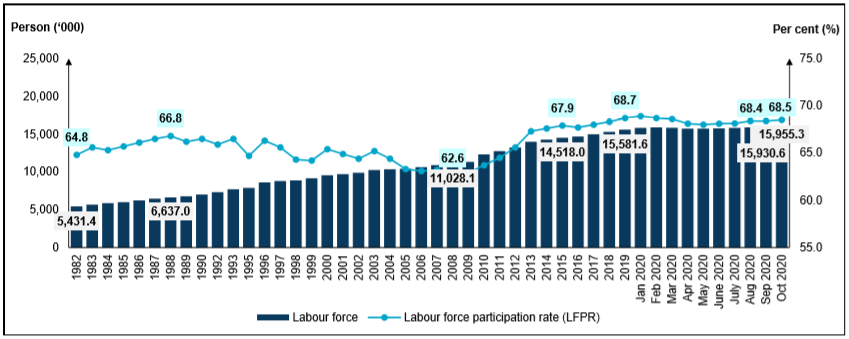
Male LFPR rose 0.1 percentage point to 80.7 per cent with the number of male labour force in October 2020 increased by 32.4 thousand persons to 9.77 million persons as compared to the previous month (September 2020: 9.74 million persons). Meanwhile, female LFPR remained at 55.2 per cent registering a total female labour force of 6.19 million in October 2020 (September 2020: 6.20 million persons). In the meantime, year-on-year comparison showed that both male and female LFPR dropped by 0.2 and 0.6 percentage points respectively. [Chart 7]
Chart 7: Labour Force and LFPR by sex, 1982 - 2019 and January - October 2020
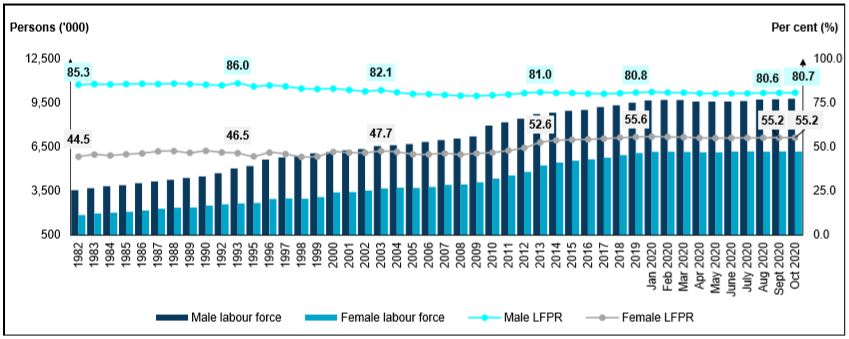
Largest composition of outside labour force due to schooling/ training
The number of persons outside labour force edged down by 0.2 per cent (-12.1 thousand persons) to 7.35 million persons during the month (September 2020: 7.36 thousand persons). In the meantime, year-on-year comparison, outside labour force rose by 2.4 per cent (+172.7 thousand persons). The largest composition of outside labour force was due to schooling/ training which contributed 43.4 per cent followed by housework/ family responsibility with a share of 41.1 per cent. [Chart 8]
Chart 8: Share of outside labour force by reasons for not seeking work, September and October 2020
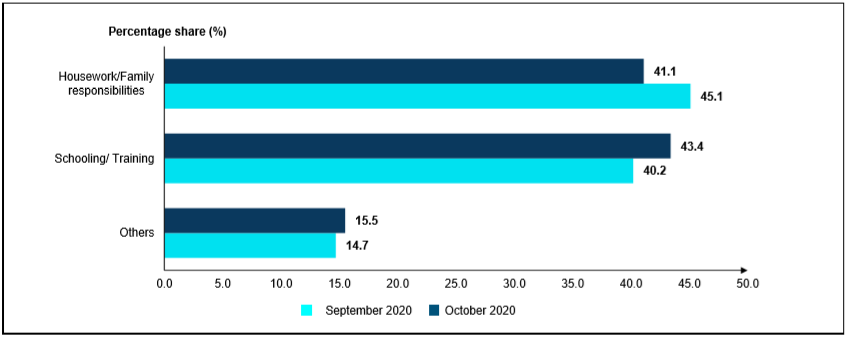
GOVERNMENT’S INITIATIVES
Budget 2021 was formulated based on three fundamental goals i.e. the people’s well-being, business continuity and economic resilience. To effectively contain the impact of COVID-19 pandemic, the Government has implemented various initiatives under the KITA PRIHATIN Economic Stimulus Package in line with the efforts to boost the economic recovery. The approaches implemented comprising of Bantuan Prihatin Nasional (BPN 2.0), Wage Subsidy Programme 2.0, and PRIHATIN Special Grant (GKP) which aims to ease the burden of the nation.
As of 20 November 2020, Wage Subsidy Programme has supported over 2.6 million employees as well as 322,177 employers through an approved allocation of RM12.49 billion. Besides, a total of 84,922 employees have managed to secure jobs, including 5,499 persons with disabilities and 351 apprentices under the Hiring Incentive Programme and Training Assistance. In assisting SMEs entrepreneurs of tourism sector, a total of RM43.7 million has been approved to 217 applications under the PENJANA Tourism Financing.
The COVID-19 pandemic and MCO has encouraged digital economy transition, thus the Reskilling and Upskilling Programme are implemented to aid the workforce to adapt with the recent changes. A total of 124,526 individuals have been approved to participate in the programmes provided under several Ministry/ agencies. Meanwhile, TEKUN Business Recovery Scheme (TBRS) has benefited 13,675 micro, small, and medium-sized enterprises with a disbursement of RM90.6 million.
The eligible SMEs were also reinforced by the PENJANA SME Financing (PSF) as part the continuity of the business recovery. Furthermore, approved applications amounted to RM11.10 billion has supported 23,637 SMEs under the supervision of Bank Negara Malaysia (BNM). Hence, it would assist in continuous recovery of the labour market.
LOOKING AHEAD
As we entered the final month of 2020, the CMCO is being lifted in phases starting 7 December, permitting inter-state travel and businesses to operate as usual. This will partly lead the economic sectors to regain its momentum following higher demand and subsequently encouraging businesses to retain or even to increase job opportunities. This positive impact has been seen when the CMCO was lifted in June where the economy improved significantly with a single-digit decline in the third quarter 2020 and the number of unemployed continued to decrease throughout June until September.
Several policies and initiatives implemented by the Government will continue to support the stabilisation of the labour market condition. Furthermore, the recent Budget 2021 announced demonstrates the government’s continuous commitments in addressing the challenges of the labour market particularly in sustaining, creating as well as protecting jobs impacted by the COVID-19 pandemic.
Among others, the Government has allocated RM3.7 billion for the Employment Generation Guarantee Scheme (JanaKerja), involving the allocation of 500,000 new job opportunities including various of upskilling and training programmes. In addition, the extension of Employment Allowance under the Employment Insurance System (SIP) for another three months was anticipated to benefit 130,000 job seekers. The Short-Term Employment Programme (MyStep) was also introduced with an allocation of RM700 million will offer 50,000 contract jobs in the public sector.
In the meantime, the Jaringan Prihatin Programme and the National Digital Networking Plan (Jendela) which was considered as the best platform were also initiated by the government in integrating the nation towards the digital world. Focusing on the digital transformation of SMEs and micro SMEs, Government has allocated RM150 million for the Shop Malaysia Online as an e-commerce initiative to motivate more consumers onboard to e-commerce and encourage existing e-commerce consumers to upsurge their spending with the local online sellers. Overall, the wide ranging of Government policy measures will assist the labour market to gradually regain its momentum in 2021.
TECHNICAL NOTES
This information is derived from the Labour Force Survey (LFS) which was conducted to collect information on the structure and distribution of labour force, employment and unemployment.
The survey population cover persons who live in private living quarters and excludes persons residing in institutions such as hotels, hostels, hospitals, prisons, boarding houses and workers residing in construction work site.
The survey comprises of the economically active and inactive population. To measure the economically active population, the LFS uses the age limit of 15 to 64 years. The economically active population comprises of those employed and unemployed whereas those who are inactive is classified as outside the labour force.
LFS uses the actual status approach, where a person is classified on the basis of his labour force activity during the reference week.
- Labour force refers to those who, during the reference week are in the 15 to 64 years (in completed years at last birthday) and who are either employed or unemployed.
- Employed refers to all persons who, at any time during the reference week worked at least one hour for pay, profit or family gain (as an employer, employee, own-account worker or unpaid family worker). Also considered as employed are persons who did not work during the reference week because of illness, injury, bad weather, leave, labour dispute and social or religious reasons but had a job, farm, enterprise or other family enterprise to return to. Also included are those on temporary lay-off with pay who would definitely be called back to work.
- Unemployed
Unemployed refers to those who do not have a job but are interested to work. There are two groups of unemployed that is the actively unemployed and inactively unemployed.
- Outside Labour Force
All persons not classified as employed or unemployed as stated above are classified as outside labour force. Includes housewives, students (including those going for further studies), retired, disabled persons and those not interested in looking for a job.
- Labour Force Participation Rate
The economic activity of a population depends on the demographic characteristics of that population. The proportion of economically active population, therefore, differs between sub-groups of that population. These variations are measured by specific activity rates termed as labour force participation rate. Labour force participation rate is defined as the ratio of the labour force to the working age population (15 to 64 years), expressed as percentage.
- Unemployment rate is the proportion of unemployed population to the total population in labour force. This rate measures the percentage of unemployed population in the labour force.
Population Benchmarks
Population by characteristics of age group, ethnicity and state were used as benchmarks to produce labour statistics.
Starting with the monthly release of the Principal Statistics of Labour Force, Malaysia, January 2016, the principal statistics of labour is estimated based on the current population estimates as compared to the previous series which used population projections based on the Population and Housing Census of Malaysia, 2010. This rebase is to obtain statistics that is more consistent with current population structure.
Released By:
DEPARTMENT OF STATISTICS, MALAYSIA
11 December 2020
Contact person:
Mohd Yusrizal bin Ab. Razak
Public Relation Officer
Strategic Communication and International Division
Department of Statistics, Malaysia
Tel : +603-8885 7942
Fax : +603-8888 9248
Email : yusrizal.razak[at]dosm.gov.my
Subscribe
Newsletter
Subscribe to our newsletter and stay updated
For interviews, press statement and clarification to the media, contact:
Baharudin Mohamad
Public Relation Officer
Email: baharudin[at]dosm.gov.my
Phone: 03 8090 4681
Not found what you looking for? Request data from us, through
Go to eStatistik
Email: data[at]dosm.gov.my
Phone: 03 8885 7128 (data request)










